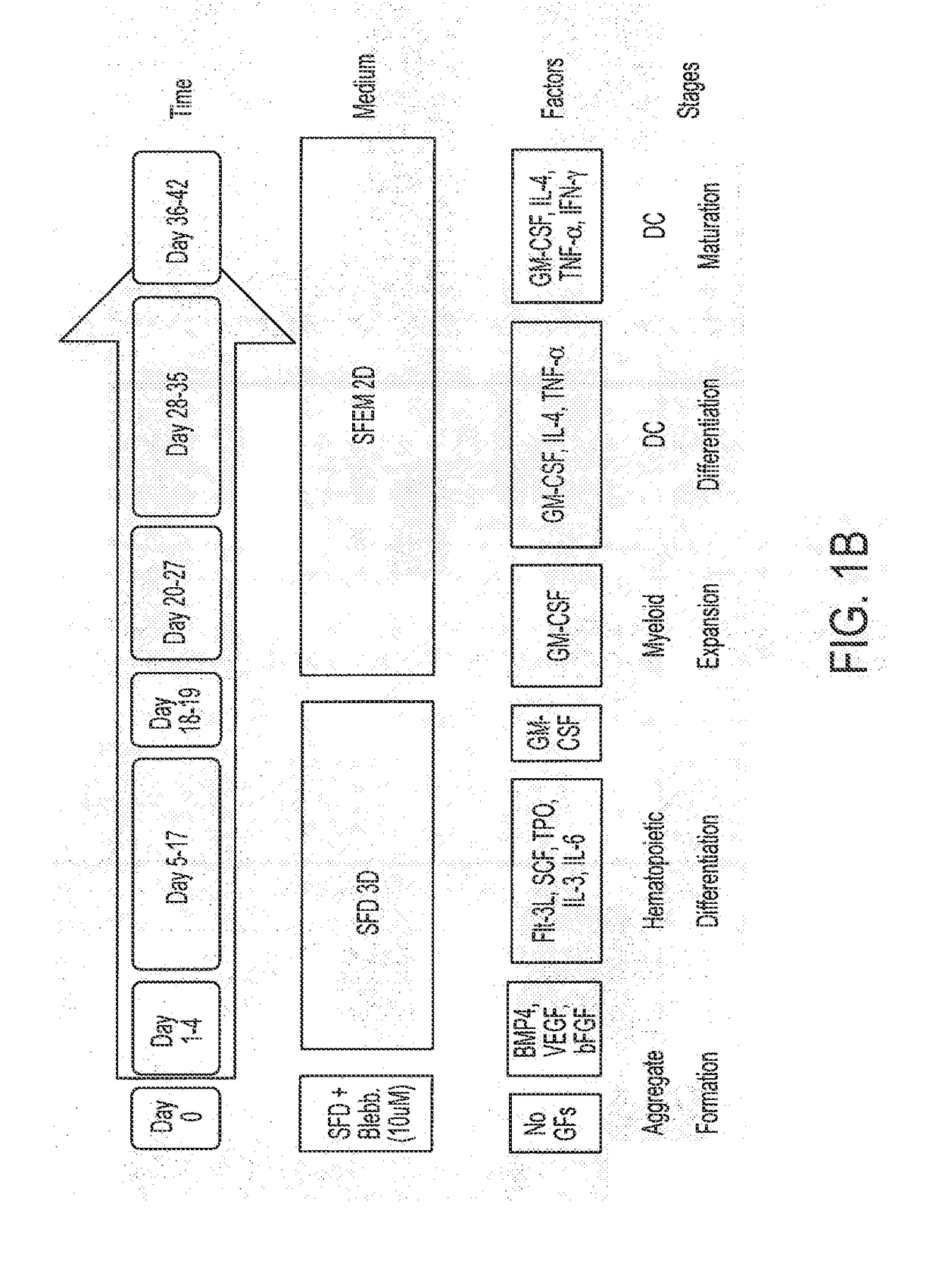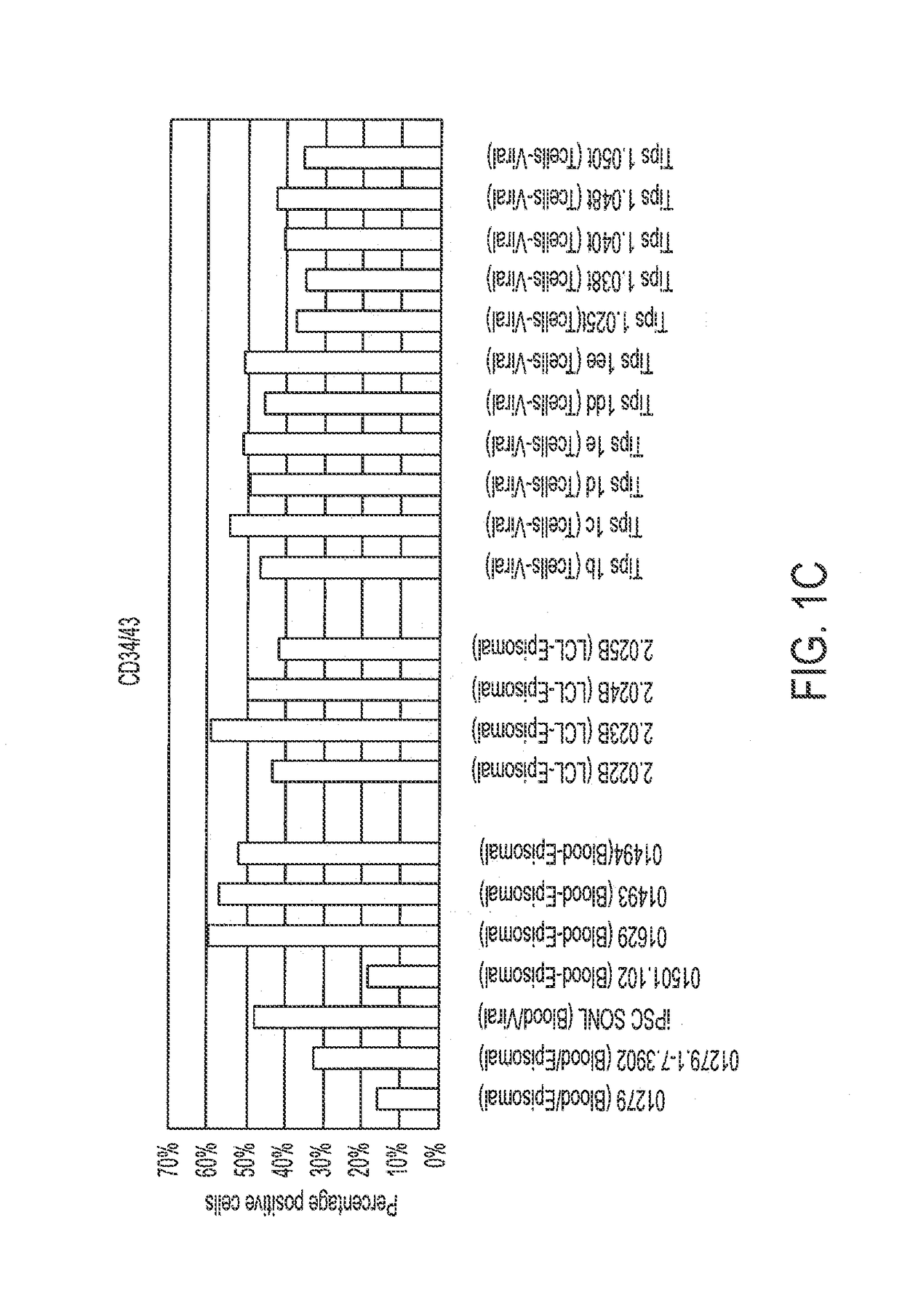Methods for directed differentiation of pluripotent stem cells to immune cells
a technology of immune cells and stem cells, applied in the field of molecular biology, can solve the problems of inconvenient previous methods for reprogramming human somatic cells, cumbersome sources for generating patient-specific stem cells, etc., and achieve the effects of promoting immune cell differentiation, promoting lymphoid differentiation, and promoting differentiation
- Summary
- Abstract
- Description
- Claims
- Application Information
AI Technical Summary
Benefits of technology
Problems solved by technology
Method used
Image
Examples
example 1
n of T Cell-Derived PSCs (TiPSCs)
[0191]For the production of iPS cells, T cells were isolated from a blood sample and activated prior to retroviral reprogramming to iPSCs. First, peripheral blood mononuclear cells (PBMCs) were expanded in freshly prepared AIM-V Medium+pen / strep / glutamine (AIV-V / ps / s / g media) (Invitrogen) plus 300 IU / ml rhIL2 (Peprotech) and 10 ng / ml soluble anti-CD3 antibody (OKT3 clone, eBiosciences) and anti-CD28 antibody. Several days after activation exponential growth was verified by CEDEX cell count. After 3 days in culture cells were assayed for T-cell phenotype and then transduced with the reprogramming factors.
[0192]Retroviral vectors Nanog RFP, Lin28 RFP, Oct4 eGFP, and Sox2 eGFP were constructed as described previously (see U.S. Application No. 61 / 088,054, incorporated herein by reference). Retroviral vectors c-Myc RFP, Klf4 RFP, Oct4 eGFP, and Sox2 eGFP were constructed similarly.
[0193]The CD3- and CD28-activated peripheral mononuclear cells were culture...
example 2
ferentiation to Hematopoietic Precursor Cells (HPCs)
[0195]Various episomally and virally reprogrammed iPSCs (Table 1), including the TiPSCs of Example 1, were subjected to the 3D differentiation protocol for the production of HPCs (FIG. 1). First, the iPSCs were acclimatized to hypoxic conditions for 5-10 passages under feeder-free conditions on Matrigel™- or Vitronectin-coated ultra-low attachment (ULA) plates in Essential 8 (E8) media. Aggregates were made from sub confluent iPSCs at a density of 0.25-0.5 million cells per ml in the presence Serum Free Defined (SFD) media supplemented with 5 uM blebbistatin. The process was performed in ultra-low attachment (ULA) plates or spinner flasks in SFD basal medium containing 75% IMDM (Invitrogen 12200-069) (with Glutamine and 25 mM HEPES+P / S), 25% Hams F12 (Mediatech 10-080-CV), 0.5% N2-supplement (Invitrogen 17502-048), 1% B27 supplement without retinoic acid (Invitrogen 12587-010), 0.05% BSA, 50 ug / ml Ascorbic acid, and 4.5×10−4 M mono...
example 3
iPSC Differentiation to Hematopoietic Precursor Cells (HPCs)
[0199]The 1C T-cell derived iPSCs (TiPSC, derived by retroviral reprogramming) were differentiated to CD34+ hematopoietic progenitors through aggregate suspension (3D) culture. 1C cells were maintained under feeder-free conditions on Matrigel™- or Vitronectin-coated 6-well plates in Essential 8 (E8) medium. Aggregates were made from sub-confluent 1C cells (<80% confluence) at a density of 0.5-1 million cells per ml in the Essential 3 (E3) medium (containing only 3 of 8 components of E8 medium: DMEM / F12 basal medium, ascorbic acid 2-phosphate magnesium and sodium selenite) supplemented with 50 ng / ml FGF2, 50 ng / ml VEGF, 2 μM CHIR99021 (GSK-3 inhibitor), and 10 μM blebbistatin (myosin-II inhibitor). The aggregate formation was performed during 24 hour culture in ultra-low attachment (ULA) flasks under continuous agitation on the rocker platform at 15 rpm (including all subsequent culture steps).
[0200]The formed cell aggregate...
PUM
| Property | Measurement | Unit |
|---|---|---|
| concentration | aaaaa | aaaaa |
| density | aaaaa | aaaaa |
| pressure | aaaaa | aaaaa |
Abstract
Description
Claims
Application Information
 Login to View More
Login to View More - R&D
- Intellectual Property
- Life Sciences
- Materials
- Tech Scout
- Unparalleled Data Quality
- Higher Quality Content
- 60% Fewer Hallucinations
Browse by: Latest US Patents, China's latest patents, Technical Efficacy Thesaurus, Application Domain, Technology Topic, Popular Technical Reports.
© 2025 PatSnap. All rights reserved.Legal|Privacy policy|Modern Slavery Act Transparency Statement|Sitemap|About US| Contact US: help@patsnap.com



